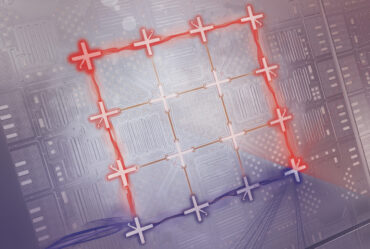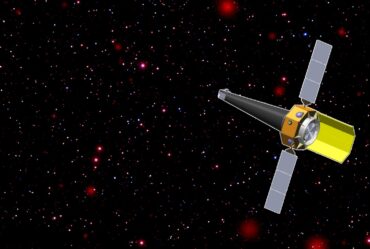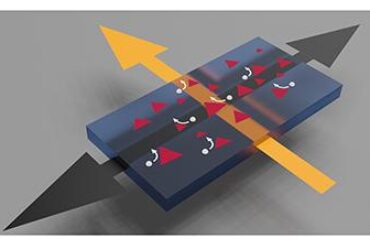
Controlling 2-D magnetism with stacking order
MIT researchers discover why magnetism in certain materials is different in atomically thin layers and their bulk forms.
Researchers led by MIT Department of Physics Professor Pablo Jarillo-Herrero last year showed that rotating layers of hexagonally structured graphene at a particular “magic angle” could change the material’s electronic properties from an insulating state to a superconducting state. Now researchers in the same group and their collaborators have demonstrated that in a different ultra-thin material that also features a honeycomb-shaped atomic structure — chromium trichloride (CrCl3) — they can alter the material’s magnetic properties by shifting the stacking order of layers.
The researchers peeled away two-dimensional (2-D) layers of chromium trichloride using tape in the same way researchers peel away graphene from graphite. Then they studied the 2-D chromium trichloride’s magnetic properties using electron tunneling. They found that the magnetism is different in 2-D and 3-D crystals due to different stacking arrangements between atoms in adjacent layers.
At high temperatures, each chromium atom in chromium trichloride has a magnetic moment that fluctuates like a tiny compass needle. Experiments show that as the temperature drops below 14 kelvins (-434.47 degrees Fahrenheit), deep in the cryogenic temperature range, these magnetic moments freeze into an ordered pattern, pointing in opposite directions in alternating layers (antiferromagnetism). The magnetic direction of all the layers of chromium trichloride can be aligned by applying a magnetic field. But the researchers found that in its 2-D form, this alignment needs a magnetic force 10 times stronger than in the 3-D crystal. The results were recently published online in Nature Physics.
“What we’re seeing is that it’s 10 times harder to align the layers in the thin limit compared to the bulk, which we measure using electron tunneling in a magnetic field,” says MIT physics graduate student Dahlia R. Klein, a National Science Foundation graduate research fellow and one of the paper’s lead authors. Physicists call the energy required to align the magnetic direction of opposing layers the interlayer exchange interaction. “Another way to think of it is that the interlayer exchange interaction is how much the adjacent layers want to be anti-aligned,” fellow lead author and MIT postdoc David MacNeill suggests.
The researchers attribute this change in energy to the slightly different physical arrangement of the atoms in 2-D chromium chloride. “The chromium atoms form a honeycomb structure in each layer, so it’s basically stacking the honeycombs in different ways,” Klein says. “The big thing is we’re proving that the magnetic and stacking orders are very strongly linked in these materials.”
“Our work highlights how the magnetic properties of 2-D magnets can differ very substantially from their 3-D counterparts,” says senior author Pablo Jarillo-Herrero, the Cecil and Ida Green Professor of Physics. “This means that we have now a new generation of highly tunable magnetic materials, with important implications for both new fundamental physics experiments and potential applications in spintronics and quantum information technologies.”
Layers are very weakly coupled in these materials, known as van der Waals magnets, which is what makes it easy to remove a layer from the 3-D crystal with adhesive tape. “Just like with graphene, the bonds within the layers are very strong, but there are only very weak interactions between adjacent layers, so you can isolate few-layer samples using tape,” Klein says.
MacNeill and Klein grew the chromium chloride samples, built and tested nanoelectronic devices, and analyzed their results. The researchers also found that as chromium trichloride is cooled from room temperature to cryogenic temperatures, 3-D crystals of the material undergo a structural transition that the 2-D crystals do not. This structural difference accounts for the higher energy required to align the magnetism in the 2-D crystals.
The researchers measured the stacking order of 2-D layers through the use of Raman spectroscopy and developed a mathematical model to explain the energy involved in changing the magnetic direction. Co-author and Harvard University postdoc Daniel T. Larson says he analyzed a plot of Raman data that showed variations in peak location with the rotation of the chromium trichloride sample, determining that the variation was caused by the stacking pattern of the layers. “Capitalizing on this connection, Dahlia and David have been able to use Raman spectroscopy to learn details about the crystal structure of their devices that would be very difficult to measure otherwise,” Larson explains. “I think this technique will be a very useful addition to the toolbox for studying ultra-thin structures and devices.” Department of Materials Science and Engineering graduate student Qian Song carried out the Raman spectroscopy experiments in the lab of MIT assistant professor of physics Riccardo Comin. Both also are co-authors of the paper.
“This research really highlights the importance of stacking order on understanding how these van der Waals magnets behave in the thin limit,” Klein says.
MacNeill adds, “The question of why the 2-D crystals have different magnetic properties had been puzzling us for a long time. We were very excited to finally understand why this is happening, and it’s because of the structural transition.”
This work builds on two years of prior research into 2-D magnets in which Jarillo-Herrero’s group collaborated with researchers at the University of Washington, led by Professor Xiaodong Xu, who holds joint appointments in the departments of Materials Science and Engineering, Physics, and Electrical and Computer Engineering, and others. Their work, which was published in a Nature letter in June 2017, showed for the first time that a different material with a similar crystal structure — chromium triiodide (CrI3) — also behaved differently in the 2-D form than in the bulk, with few-layer samples showing antiferromagnetism unlike the ferromagnetic 3-D crystals.
Jarillo-Herrero’s group went on to show in a May 2018 Science paper that chromium triiodide exhibited a sharp change in electrical resistance in response to an applied magnetic field at low temperature. This work demonstrated that electron tunneling is a useful probe for studying magnetism of 2-D crystals. Klein and MacNeill were also the first authors of this paper.
University of Washington Professor Xiaodong Xu says of the latest findings, “The work presents a very clever approach, namely the combined tunneling measurements with polarization resolved Raman spectroscopy. The former is sensitive to the interlayer antiferromagnetism, while the latter is a sensitive probe of crystal symmetry. This approach gives a new method to allow others in the community to uncover the magnetic properties of layered magnets.”
“This work is in concert with several other recently published works,” Xu says. “Together, these works uncover the unique opportunity provided by layered van der Waals magnets, namely engineering magnetic order via controlling stacking order. It is useful for arbitrary creation of new magnetic states, as well as for potential application in reconfigurable magnetic devices.”
Other authors contributing to this work include Efthimious Kaxiras, the John Hasbrouck Van Vleck Professor of Pure and Applied Physics at Harvard University; Harvard graduate student Shiang Fang; Iowa State University Distinguished Professor (Condensed Matter Physics) Paul C. Canfield; Iowa State graduate student Mingyu Xu; and Raquel A. Ribeiro, of Iowa State University and the Federal University of ABC, Santo André, Brazil. This work was supported in part by the Center for Integrated Quantum Materials, the U.S. Department of Energy Office of Science Basic Energy Sciences Program, the Gordon and Betty Moore Foundation’s EPiQS Initiative, and the Alfred P. Sloan Foundation.


